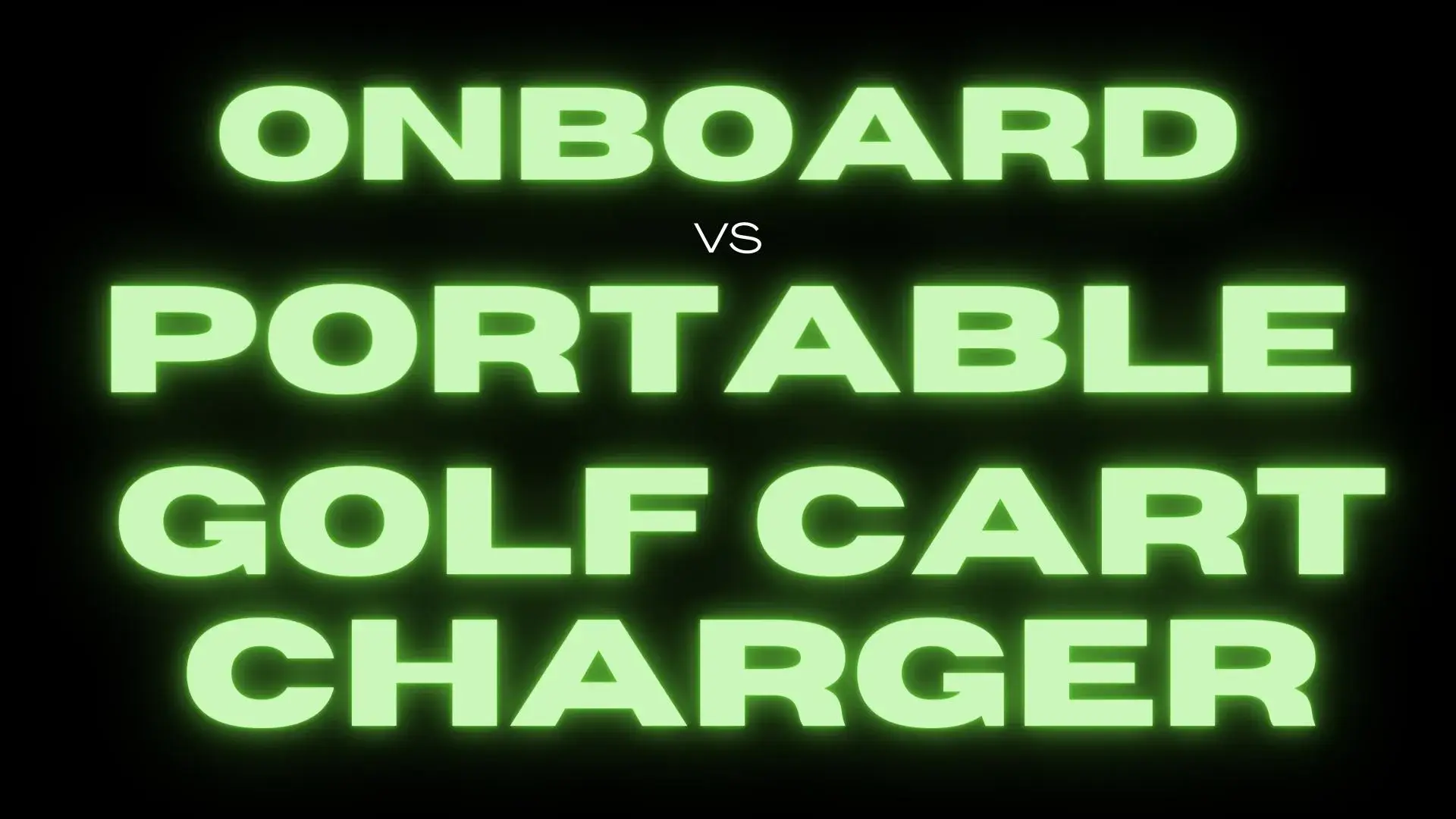Discover the perfect charger for your Golf Cart. Onboard vs Portable Golf Cart Charger – which one will give you the power you need to win?
Are you tired of dealing with unreliable golf cart chargers? As a golfer, I know how important it is to have a reliable charger.
But with so many different types of chargers available, it can be challenging to know which one is right for you. As someone who has been in your golf shoes, I set out to find the answer to this question.
In this article, I’ll answer the question of whether an on-board or portable golf cart charger is better for your game. The answer is, based on my needs, I chose an onboard charger.
But, various factors, such as course layout and frequency of use, may make an on-board charger a better option for you. I’ll provide you with the information you need to make an informed decision that suits your game.
Let’s Tee Off!
Table of Contents
Key Takeaways
- Onboard and portable chargers have different pros and cons.
- Consider factors such as convenience, cost, and durability when choosing.
- Your unique golf cart needs and usage patterns should drive your decision.
| Onboard chargers | Portable chargers |
|---|---|
| PROS | PROS |
|
|
| CONS | CONS |
|
|
Onboard Vs Portable Golf Cart Charger
If you’re a golf cart owner, you need to know the difference between onboard and portable chargers. So, let’s dive into their unique features and advantages.
The golf cart has built-in onboard chargers fixed in place as you ride around. No need to worry about forgetting it, because it’s always with you! When your battery is running low, plug it in anywhere, and you’re good to go.
Portable chargers are stand-alone chargers separate from the golf cart. You can store them in your garage or any other location when not in use. Need to charge your battery? Connect the portable charger to your cart, and you’re all set.
So which one is better for you? It depends on your preferences and how you use your golf cart. Onboard chargers provide constant accessibility and convenience. In contrast, portable chargers offer more flexibility in storage and usage.
Do you often use your golf cart in dusty or muddy environments? Remember, onboard chargers may be more affected by dust and moisture.
But you want the head to head. So, let’s compare onboard and standalone chargers for the most important attributes.

Durability
Manufacturers build onboard chargers to last. They can handle rough weather, bumps, and vibrations during golf cart rides, no problem. What about portable chargers? Well, they might not be as tough. Moisture, dust, heat, and impact can affect them more easily. And they are easier to drop, break, or otherwise damage.
So, what can you do? Keep both types of chargers in good shape! Regular maintenance helps extend their lifespan and performance. Taking care of your charger means a smoother ride for you and your golf cart.
WINNER: ONBOARD
Efficiency
Manufacturers often design onboard chargers to work with a specific golf cart battery system. This means their charging was sometimes more efficient than portable chargers.
The charger adjusts the current and voltage based on the battery’s capacity and temperature. This is good news for the performance and longevity of the batteries.
But some portable chargers are now as efficient as onboard chargers. It depends on their features and specifications. Nowadays, modern portable chargers use smart charging algorithms.
They optimize the charging process to prevent overcharging or undercharging. Some portable chargers may also have a higher amp rating or a faster charging speed than others.
So, onboard chargers were generally more efficient than portable ones, but the gap may not be too big these days.
When choosing a charger, it’s best to pick one with a smart charging algorithm. This applies to both onboard and portable chargers. This means that your golf cart battery is always charged as efficiently as possible.
And your needs can change depending on the age of your cart and its charger. Your cart’s original charger may no longer be the best fit for your current needs. It may be outdated, damaged, or superseded by more advanced models. If this is the case, you may want to consider an aftermarket charger. It may offer better features and performance.
WINNER: ONBOARD
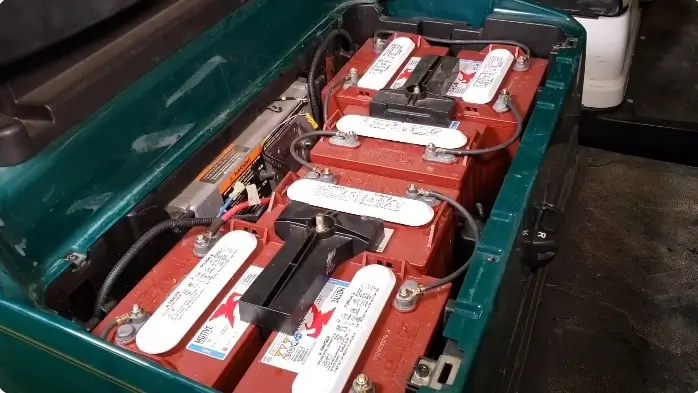
Convenience
Convenience is a subjective measure, so I can only give my opinion. And I prefer onboard, every time. Onboard chargers are much more convenient than portable chargers. They stay with the golf cart when needed and can plug in anywhere. Say goodbye to the hassle of carrying or storing a separate charger.
In contrast, portable chargers demand (a little) more effort. You have to take it with you, which is annoying, or wait until you get back to base for a charge. When not in use, you’ll need a dedicated space for storage.
Now, let’s talk about user-friendliness for a moment. Both chargers, whether on board or portable, are easy to use. After all, that is the purpose they are designed for. So, what features should you look for?
A clear interface that displays charging status, error codes, and other vital information is a plus if you want to stay on top of the details.
But for me, I like a plug-and-play operation that rules out complex settings or adjustments.
So, onboard chargers might have the upper hand when it comes to convenience. But your ideal choice depends on your preferences and how you use your cart.
WINNER: ONBOARD
Installation
So, you’re wondering about the difficulties of onboard charger installation. Is it worth the bother? Let’s dive in!
On-Board Chargers
There’s no getting around it. Onboard chargers are a pain to install. You’ll need to wire or mount them to your golf cart chassis or frame.
This involves finding a safe and accessible spot on your cart. Different models or brands may call for modifications or accessories for proper fitting.
Otherwise, you can pay someone to install it for you. This saves the hassle but adds to the expense.
Take a look at this video for a better idea of what’s involved.
Portable Chargers
No need for painful installation here. Plug and go.
WINNER: PORTABLE
Cost
Onboard chargers are often more expensive and pricier than portables.
Why? They often come with more advanced features, high-quality components, and longer warranties. You might have to pay more to install it, and there could be extra costs for accessories or modifications. But remember, sometimes you get what you pay for.
In contrast, portable chargers tend to be less expensive. They usually have fewer features, lower-quality components, and shorter warranty periods. And if you’re on a budget, these chargers save you money on installation costs.
But don’t only look at the buy price. Consider the expenses of using and maintaining both chargers, including buying new ones.
WINNER: PORTABLE
Space
When it comes to golf cart chargers, space is worth some thought. Let’s compare on-board and portable chargers by space and weight.
Onboard chargers often take up more space than portable chargers. Why? They are attached to the golf cart. They occupy some of the storage or passenger space. And they add a little weight to the golf cart, which can affect its balance or performance, albeit only a little.
If you leave your portable charger at home, it takes up no cart space at all.
So, consider a few things. Look at the available space and weight capacity of your golf cart. Think about how you want to use it.
WINNER: PORTABLE
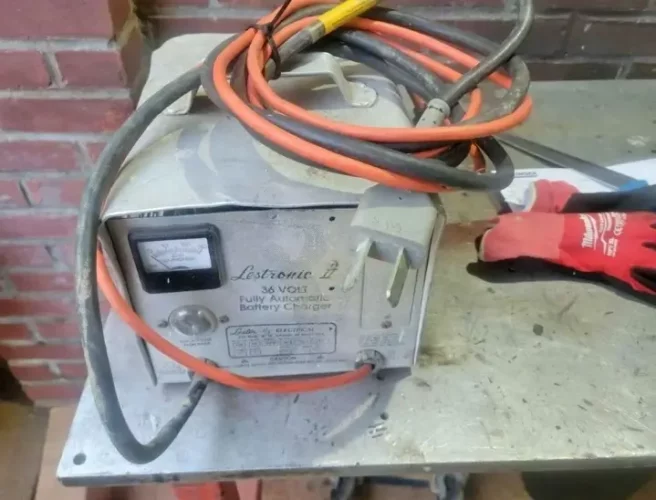
Safety
Safety is a key consideration when it comes to on-board and portable golf cart chargers.
Onboard chargers have built-in safety features. These include overcharge protection and temperature compensation.
Because of these features, you can trust that your charger is working well and safely. Plus, since it’s always with your golf cart, you won’t have to worry about it getting lost or damaged.
But what about portable chargers? They have similar safety features. So this is a draw.
WINNER: DRAW
Compatibility
Now, let’s talk about compatibility. No matter which charger you choose, it needs to be compatible with your golf cart battery. If it’s not compatible, the charger won’t work. Or worse, you risk damaging your battery or creating a potential fire hazard.
So, always double-check your golf cart battery requirements before buying a charger.
WINNER: DRAW
On Board Golf Cart Battery Chargers
So let’s round up their advantages and disadvantages, along with a couple of examples.
Advantages
Always with your cart, onboards are more convenient than standalones. They’re more durable, can withstand difficult conditions, and often last longer.
Disadvantages
But there are some downsides to onboard chargers. The prices for them can be higher, with extra charges for installation and accessories. They can take up more room in your golf cart and make it heavier.
Let’s look at two examples of onboard golf cart battery chargers:
FORM 15 AMP Onboard 48V Golf Cart Battery Charger
This FORM 15A Onboard 48V charger has a 15 amp rapid charging capacity. It uses 7-stage smart charging technology to charge lead-acid batteries. It is also water and dust-resistant with an IP67 rating.
Lester Summit Series II On-Board 36V Battery Charger 29100G9
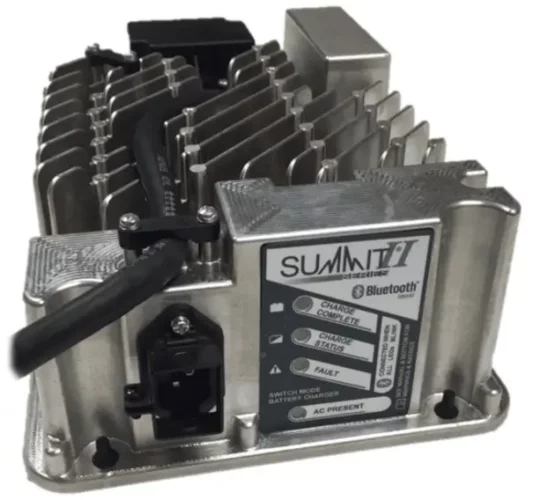
The Lester Summit Series II 36V charger can charge both 36V and 48V batteries, which is ideal for golf cart batteries. The Bluetooth app allows you to monitor and configure the charger wirelessly. It also has auto-sensing universal AC input so that it can operate worldwide. 8.5 foot cord.
Portable Golf Cart Battery Chargers
Are you leaning toward a portable golf cart battery charger? Let’s round up their advantages, disadvantages, and key features.
Advantages
Portable chargers are cheaper. They are less complicated and do not need installation.
Disadvantages
Less convenient in many ways. They are also less durable. Portable chargers may not withstand harsh conditions and could wear out faster.
With these points in mind, let’s take a look at a few popular portable charger options:
Yamaha G19 & G22 Golf Cart 48 Volt 17 Amp 2-pin Charger
This is a 48 Volt 17 Amp Yamaha G19 & G22 Golf Cart Charger. This charger is smart and versatile. It works with 2 Pin “Nabson” round power supply. It is for Yamaha G19 & G22 electric 48-volt golf cart models. To improve battery life, a microprocessor adjusts how the battery charges. This adjustment takes into account battery capacity and ambient temperature. The product also uses efficient soft-switch technology. This reduces power use and improves reliability.
The MODZ Max48 15 AMP Club Car Battery Charger 48 Volt
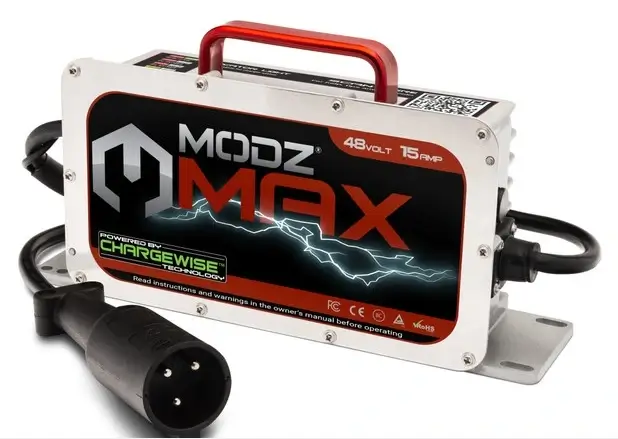
The MODZ Max48 15 AMP Club Car Battery Charger for 48 Volt Golf Carts is smart and versatile. The charging process changes according to battery capacity and temperature using a microprocessor. This means optimal performance and battery longevity. It also uses high-efficiency soft-switch technology to reduce power consumption and enhance reliability.
Before You Go …
As a golfer, you know that a dead golf cart battery can be a game-changer. But did you know that how often you charge your batteries could be the key to avoiding this problem?
In my next article, “How Often Should I Charge My Golf Cart Batteries,” I’ll explain why this is the case and provide you with the information you need to keep your batteries charged and ready to go.
Don’t miss out on this essential information that could save you from a frustrating experience on the course.
Frequently Asked Questions
Here’s the FAQs
What are the advantages of using a portable golf cart charger?
A portable golf cart charger offers flexibility and convenience. You can take it with you wherever you go. This makes it ideal for users who play on various courses or have many charging stations. Plus, it’s simple to upgrade if you ever change your cart’s battery voltage.
How do onboard chargers compare to portable chargers?
Onboard chargers are often more expensive but provide added convenience. The chargers are always in the cart and connect straight to its power supply. It means you don’t need to carry a separate charger, and the charging process is more streamlined. But portable chargers have the upper hand for flexibility and availability.
Can a portable charger fully charge my golf cart?
Yes, portable chargers can charge your golf cart in full. When choosing a charger for your cart’s battery, make sure it has the correct voltage. Also, check the charging time.
How do I choose the right charger for my golf cart?
First, identify your golf cart’s battery voltage (36V, 42V, or 48V) to choose the right charger. Check the charging specifications of potential chargers. Then verify its compatibility with your cart’s battery type.
What are some common issues with golf cart chargers?
Common issues include:
- Faulty connections. Check the connections between the charger and the cart. Check the plugs and maintain clean contacts.
- Charger malfunction: Internal components or wear and tear can lead to malfunctions. Replace or repair the charger if necessary.
- Battery issues: Damaged or worn-out batteries could affect charging performance. Inspect your batteries and replace them if needed.
How do I maintain my golf cart charger for optimal performance?
Proper maintenance can prolong your charger’s life and promote optimal performance. Make sure to:
- Keep the charger clean and free of debris.
- Inspect and tighten connections regularly.
- Store the charger in a cool, dry place when not in use.
Related Posts
- Can You Charge A Golf Cart With A 12-Volt Charger? Don’t Try It Before Reading This Guide!
- How Long Can A Golf Cart Battery Last On One Charge? Rev Up Your Ride With These Simple Steps
- How to Store Golf Cart Batteries: 9 crucial steps you NEED to know!
- How Do Golf Cart Battery Chargers Work? Unlock the Secrets of These Game-Changing Devices

